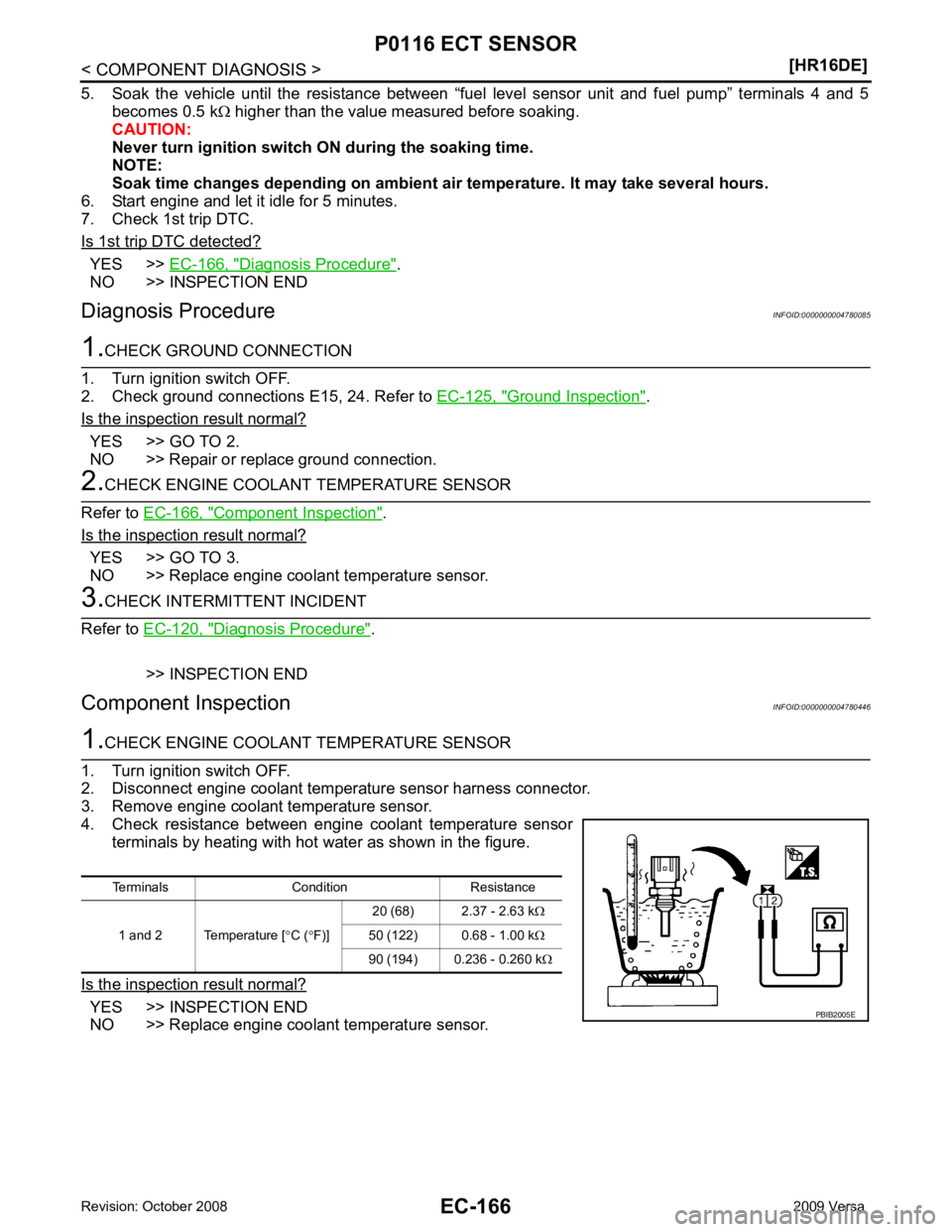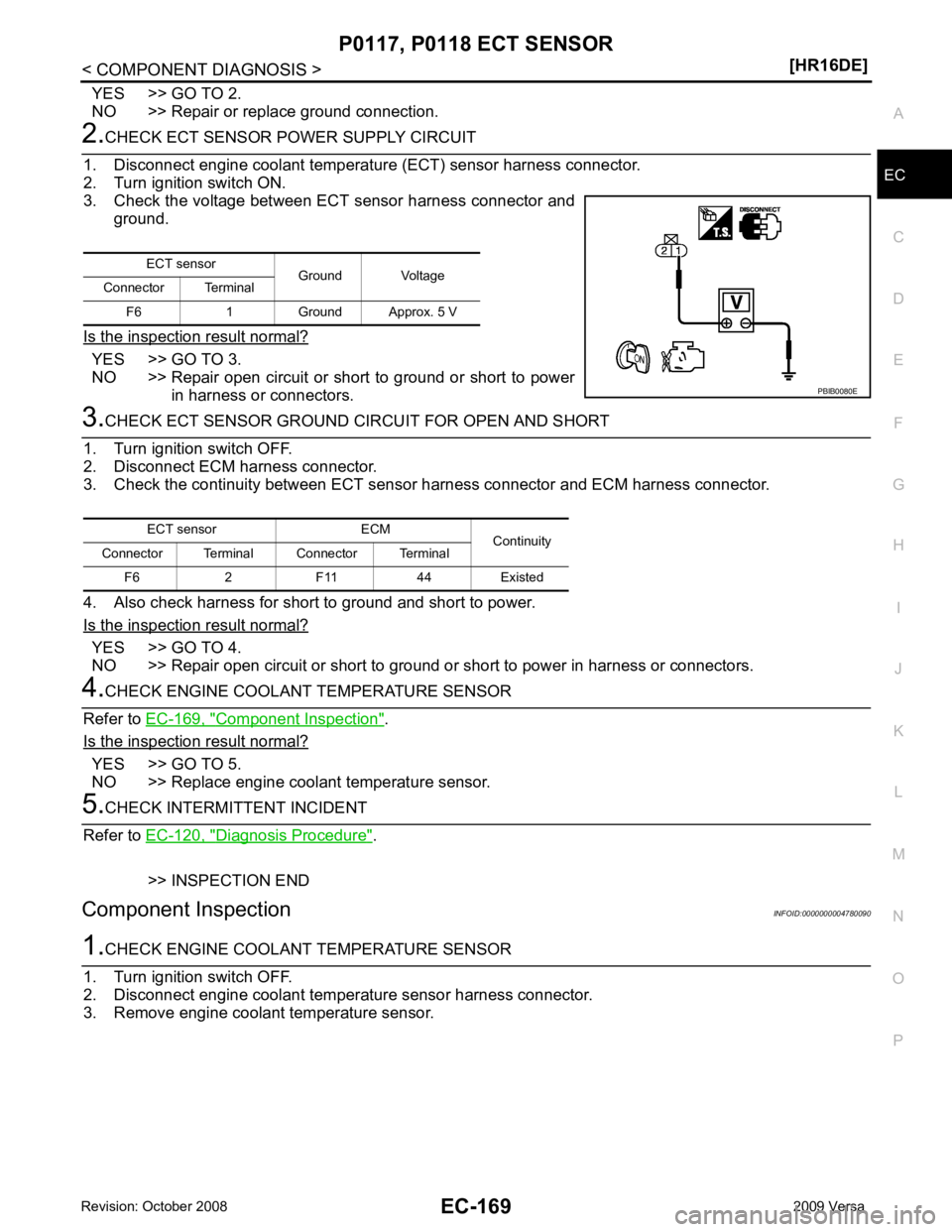2009 NISSAN LATIO coolant temperature
[x] Cancel search: coolant temperaturePage 1457 of 4331

EC
NP
O
• The B counter will be cleared when the malfunction is
detected once regardless of the driving pattern.
• The B counter will be counted up when driving pattern B is satisfied without any malfunction.
• The MIL will go off when the B counter reaches 3. (*2 in “OBD SYSTEM OPERATION CHART”)
Driving pattern C means the vehicl e operation as per the following:
The following conditions should be satisfied at the same time:
Engine speed: (Engine speed in the freeze frame data) ± 375 rpm
Calculated load value: (Calculated load value in the freeze frame data) x (1 ± 0.1) [%]
Engine coolant temperature (T) condition:
• When the freeze frame data shows lower than 70 °C (158 °F), T should be lower than 70 °C (158 °F).
• When the freeze frame data shows higher than or equal to 70 °C (158 °F), T should be higher than or equal to
70 °C (158 °F).
Example:
If the stored freeze frame data is as per the following:
Engine speed: 850 rpm, Calculated load val ue: 30%, Engine coolant temperature: 80°C (176 °F)
To be satisfied with driving pattern C, the v ehicle should run under the following conditions:
Engine speed: 475 - 1,225 rpm, Calculated load value: 27 - 33%, Engine coolant temperature: more than 70°C
(158 °F)
• The C counter will be cleared when the malfunction is detected regardless of vehicle conditions above.
• The C counter will be counted up when vehicle conditions above is satisfied without the same malfunction.
• The DTC will not be displayed after C counter reaches 80.
• The 1st trip DTC will be cleared when C counter is counted once without the same malfunction after DTC is
stored in ECM.
Relationship Between MIL, DTC, 1st Tr ip DTC and Driving Patterns Except For “Misfire
Page 1462 of 4331

Monitored item Unit Description Remarks
ENG SPEED rpm • Indicates the engine speed computed from the signal
of the crankshaft position sensor (POS) and camshaft
position sensor (PHASE). • Accuracy becomes poor if engine
speed drops below the idle rpm.
• If the signal is interrupted while the engine is running, an abnormal value
may be indicated.
MAS A/F SE-B1 V • The signal voltage of the mass air flow sensor is dis-
played. • When the engine is stopped, a certain
value is indicated.
• When engine is running specification range is indicated in “SPEC”.
B/FUEL SCHDL ms • “Base fuel schedule” indicates the fuel injection pulse
width programmed into ECM, prior to any learned on
board correction. • When engine is running specification
range is indicated in “SPEC”.
A/F ALPHA-B1 % • The mean value of the air-fuel ratio feedback correc-
tion factor per cycle is indicated. • When the engine is stopped, a certain
value is indicated.
• This data also includes the data for
the air-fuel ratio learning control.
• When engine is running specification range is indicated in “SPEC”.
COOLAN TEMP/S °C or °F • The engine coolant temperature (determined by the
signal voltage of the engine coolant temperature sen-
sor) is displayed. • When the engine coolant temperature
sensor is open or short-circuited,
ECM enters fail-safe mode. The en-
gine coolant temperature determined
by the ECM is displayed.
A/F SEN1 (B1) V • The A/F signal computed from the input signal of the
air fuel ratio (A/F) se nsor 1 is displayed.
Page 1465 of 4331

EC
NP
O
Test Item
*: Leaving cooling fan OFF with CONSULT-III while engine is running may cause the engine to overheat.
DTC & SRT CONFIRMATION MODE
SRT STATUS Mode For details, refer to EC-90, " Diagnosis Description " .
SRT WORK SUPPORT Mode This mode enables a technician to drive a vehicle to set the SRT while monitoring the SRT status.
DTC WORK SUPPORT Mode TEST ITEM CONDITION JUDGMENT CHECK ITEM (REMEDY)
FUEL INJECTION • Engine: Return to the original
trouble condition
• Change the amount of fuel injec- tion using CONSULT-III. If trouble symptom disappears, see
CHECK ITEM. • Harness and connectors
• Fuel injector
• Air fuel ratio (A/F) sensor 1
IGNITION TIMING • Engine: Return to the original
trouble condition
• Timing light: Set
• Retard the ignition timing using
CONSULT-III. If trouble symptom disappears, see
CHECK ITEM. • Perform Idle Air Volume Learning.
POWER BALANCE • Engine: After warming up, idle
the engine.
• A/C switch OFF
• Selector lever: P or N position (A/ T), Neutral position (M/T)
• Cut off each fuel injector signal
one at a time using CONSULT-
III. Engine runs rough or dies.
• Harness and connectors
• Compression
• Fuel injector
• Power transistor
• Spark plug
• Ignition coil
COOLING FAN* • Ignition switch: ON
• Turn the cooling fan “LOW”, “HI”
and “OFF” using CONSULT-III. Cooling fan moves and stops.
• Harness and connectors
• IPDM E/R (Cooling fan relay)
• Cooling fan motor
ENG COOLANT
TEMP • Engine: Return to the original
trouble condition
• Change the engine coolant tem-
perature using CONSULT-III. If trouble symptom disappears, see
CHECK ITEM. • Harness and connectors
• Engine coolant temperature sen- sor
• Fuel injector
FUEL PUMP RELAY • Ignition switch: ON (Engine
stopped)
• Turn the fuel pump relay “ON”
and “OFF” using CONSULT-III
and listen to operating sound. Fuel pump relay makes the operat-
ing sound. • Harness and connectors
• Fuel pump relay
PURG VOL CONT/V • Engine: After warming up, run
engine at 1,500 rpm.
• Change the EVAP canister purge volume control solenoid
valve opening percent using
CONSULT-III. Engine speed changes according
to the opening percent. • Harness and connectors
• Solenoid valve
FUEL/T TEMP SEN • Change the fuel tank temperature using CONSULT-III.
VENT CONTROL/V • Ignition switch: ON (Engine
stopped)
• Turn solenoid valve “ON” and “OFF” using th e CONSULT-III
and listen to operating sound. Solenoid valve makes an operating
sound. • Harness and connectors
• Solenoid valve
V/T ASSIGN ANGLE • Engine: Return to the original
trouble condition
• Change intake valve timing us-
ing CONSULT-III. If trouble symptom disappears, see
CHECK ITEM. • Harness and connectors
• Intake valve timing control sole- noid valve
Page 1521 of 4331
![NISSAN LATIO 2009 Service Repair Manual P0116 ECT SENSOR
EC-165
< COMPONENT DIAGNOSIS >
[HR16DE] C
D E
F
G H
I
J
K L
M A EC
NP
O
P0116 ECT SENSOR
Description INFOID:0000000004780447
The engine coolant temperature sensor is used to detect th NISSAN LATIO 2009 Service Repair Manual P0116 ECT SENSOR
EC-165
< COMPONENT DIAGNOSIS >
[HR16DE] C
D E
F
G H
I
J
K L
M A EC
NP
O
P0116 ECT SENSOR
Description INFOID:0000000004780447
The engine coolant temperature sensor is used to detect th](/manual-img/5/57359/w960_57359-1520.png)
P0116 ECT SENSOR
EC-165
< COMPONENT DIAGNOSIS >
[HR16DE] C
D E
F
G H
I
J
K L
M A EC
NP
O
P0116 ECT SENSOR
Description INFOID:0000000004780447
The engine coolant temperature sensor is used to detect the engine
coolant temperature. The sensor modifies a voltage signal from the
ECM. The modified signal returns to the ECM as the engine coolant
temperature input. The sensor uses a thermistor which is sensitive to
the change in temperature. The electrical resistance of the ther-
mistor decreases as temperature increases.
*: These data are reference values and are measured between ECM terminal 38
(Engine coolant temperature sensor) and ground.
CAUTION:
Do not use ECM ground terminals when measuring input/output vo ltage. Doing so may result in damage to the ECM's transis-
tor. Use a ground other than ECM terminals, such as the ground.
DTC Logic INFOID:0000000004780084
DTC DETECTION LOGIC NOTE:
If DTC P0116 is displayed with P0117 or P0118, first perform the trouble diagnosis for DTC P0117,
P0118. Refer to EC-167, " DTC Logic " .
DTC CONFIRMATION PROCEDURE 1.
PRECONDITIONING
If DTC confirmation procedure has been previously conduc ted, always turn ignition switch OFF and wait at
least 10 seconds before conducting the next test.
>> GO TO 2. 2.
PERFORM DTC CONFIRMATION PROCEDURE
1. Start engine and warm it up to normal operating temperature.
2. Rev engine up to 2,000 rpm for more than 10 minutes.
3. Move the vehicle to a cool place, then stop engine and turn ignition switch OFF.
4. Check resistance between “fuel level s ensor unit and fuel pump” terminals 4 and 5. SEF594K
Engine coolant temperature
[° C ( °F)] Voltage* (V) Resistance (k
Ω)
–10 (14) 4.4 7.0 - 11.4 20 (68) 3.5 2.37 - 2.63
50 (122) 2.2 0.68 - 1.00
90 (194) 0.9 0.236 - 0.260 SEF012P
DTC No. Trouble diagnosis name DTC detecting condition Possible cause
P0116 Engine coolant temperature
sensor circuit range/perfor-
mance Engine coolant temperature signal from engine
coolant temperature sensor does not fluctuate,
even when some time has passed after starting
the engine with pre-warming up condition. • Harness or connectors
(High or low resistance in the circuit)
• Engine coolant temperature sensor
Page 1522 of 4331

YES >>
EC-166, " Diagnosis Procedure " .
NO >> INSPECTION END
Diagnosis Procedure INFOID:0000000004780085Ground Inspection " .
Is the inspection result normal? YES >> GO TO 2.
NO >> Repair or replace ground connection. Component Inspection " .
Is the inspection result normal? YES >> GO TO 3.
NO >> Replace engine coolant temperature sensor. Diagnosis Procedure " .
>> INSPECTION END
Component Inspection INFOID:0000000004780446YES >> INSPECTION END
NO >> Replace engine coolant temperature sensor. Terminals Condition Resistance
1 and 2 Temperature [ °C ( °F)] 20 (68) 2.37 - 2.63 k
Ω
50 (122) 0.68 - 1.00 k Ω
90 (194) 0.236 - 0.260 k Ω
Page 1523 of 4331
![NISSAN LATIO 2009 Service Repair Manual P0117, P0118 ECT SENSOR
EC-167
< COMPONENT DIAGNOSIS >
[HR16DE] C
D E
F
G H
I
J
K L
M A EC
NP
O
P0117, P0118 ECT SENSOR
Description INFOID:0000000004780087
The engine coolant temperature sensor is use NISSAN LATIO 2009 Service Repair Manual P0117, P0118 ECT SENSOR
EC-167
< COMPONENT DIAGNOSIS >
[HR16DE] C
D E
F
G H
I
J
K L
M A EC
NP
O
P0117, P0118 ECT SENSOR
Description INFOID:0000000004780087
The engine coolant temperature sensor is use](/manual-img/5/57359/w960_57359-1522.png)
P0117, P0118 ECT SENSOR
EC-167
< COMPONENT DIAGNOSIS >
[HR16DE] C
D E
F
G H
I
J
K L
M A EC
NP
O
P0117, P0118 ECT SENSOR
Description INFOID:0000000004780087
The engine coolant temperature sensor is used to detect the engine
coolant temperature. The sensor modifies a voltage signal from the
ECM. The modified signal returns to the ECM as the engine coolant
temperature input. The sensor uses a thermistor which is sensitive to
the change in temperature. The electrical resistance of the ther-
mistor decreases as temperature increases.
*: These data are reference values and are measured between ECM terminal 38
(Engine coolant temperature sensor) and ground.
CAUTION:
Do not use ECM ground terminals when measuring input/output vo ltage. Doing so may result in damage to the ECM's transis-
tor. Use a ground other than ECM terminals, such as the ground.
DTC Logic INFOID:0000000004780088
DTC DETECTION LOGIC
DTC CONFIRMATION PROCEDURE 1.
PRECONDITIONING
If DTC Confirmation Procedure has been previously conduc ted, always turn ignition switch OFF and wait at
least 10 seconds before conducting the next test.
>> GO TO 2. 2.
PERFORM DTC CONFIRMATION PROCEDURE
1. Turn ignition switch ON and wait at least 5 seconds.
2. Check DTC.
Is DTC detected? YES >> Go to
EC-168, " Diagnosis Procedure " .
NO >> INSPECTION END SEF594K
Engine coolant temperature
[° C ( °F)] Voltage* (V) Resistance (k
Ω)
–10 (14) 4.4 7.0 - 11.4 20 (68) 3.5 2.37 - 2.63
50 (122) 2.2 0.68 - 1.00
90 (194) 0.9 0.236 - 0.260 SEF012P
DTC No. Trouble diagnosis name DTC detecting condition Possible Cause
P0117 Engine coolant temperature
sensor circuit low input An excessively low voltage from the sensor
is sent to ECM. • Harness or connectors
(The sensor circuit is open or shorted.)
• Engine coolant temperature sensor
P0118 Engine coolant temperature
sensor circuit high input An excessively high voltage from the sensor
is sent to ECM.
Page 1525 of 4331

EC
NP
O
YES >> GO TO 2.
NO >> Repair or replace ground connection. YES >> GO TO 3.
NO >> Repair open circuit or short to ground or short to power
in harness or connectors. YES >> GO TO 4.
NO >> Repair open circuit or short to ground or short to power in harness or connectors. Component Inspection " .
Is the inspection result normal? YES >> GO TO 5.
NO >> Replace engine coolant temperature sensor. Diagnosis Procedure " .
>> INSPECTION END
Component Inspection INFOID:0000000004780090
Page 1526 of 4331
![NISSAN LATIO 2009 Service Repair Manual EC-170< COMPONENT DIAGNOSIS >
[HR16DE]
P0117, P0118 ECT SENSOR
4. Check resistance between engine coolant temperature sensor terminals by heating with hot water as shown in the figure.
Is the in NISSAN LATIO 2009 Service Repair Manual EC-170< COMPONENT DIAGNOSIS >
[HR16DE]
P0117, P0118 ECT SENSOR
4. Check resistance between engine coolant temperature sensor terminals by heating with hot water as shown in the figure.
Is the in](/manual-img/5/57359/w960_57359-1525.png)
EC-170< COMPONENT DIAGNOSIS >
[HR16DE]
P0117, P0118 ECT SENSOR
4. Check resistance between engine coolant temperature sensor terminals by heating with hot water as shown in the figure.
Is the inspection result normal? YES >> INSPECTION END
NO >> Replace engine coolant temperature sensor. Terminals Condition Resistance
1 and 2 Temperature [ °C ( °F)] 20 (68) 2.37 - 2.63 k
Ω
50 (122) 0.68 - 1.00 k Ω
90 (194) 0.236 - 0.260 k Ω PBIB2005E